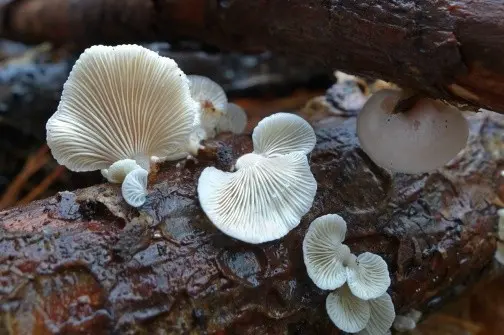Contents
Crepidote flattened is a widespread species of the Volokonnitsa family. Fruit bodies form on decaying wood. In the scientific community it is known under the names: Crepidotus applanatus, Agaricus applanatus, Agaricus planus.

What flattened crepidotes look like
The semicircular, small fruiting body of a saprotroph growing on decaying wood is shaped like a scallop shell. Attaches with a rudimentary leg to a rotting or weakened trunk. The width of the cap is from 1 to 4 cm, convex at first, gradually opening as it grows. The border is bent, sometimes in stripes. The whole fruiting body is soft, slightly flabby, quickly saturated with liquid in rainy weather. The skin is smooth to the touch, slightly velvety at the base. Young mushrooms are white, later becoming light brown.
In frequent, adherent plates, the edges are even. The color changes from white to brown. The leg is attached sideways to the substrate. Sometimes it’s completely invisible. Small spikes are visible at the attachment point on the fruiting bodies.
The thin pulp is white, soft, with an unexpressed smell, pleasant taste. In young fruiting bodies it is watery. The mass of mature spores is ocher-brown or with a brownish tinge.

Where flattened crepidotes grow
The distribution of fungi throughout the warm period – in Eurasia and America:
- settle on deciduous and coniferous species;
- prefer the wood of hornbeam, beech, maple;
- rarely found on fir and spruce.
Is it possible to eat crepidotes
The species is considered inedible. In science, its properties are little known.
How to distinguish flattened crepidotes
Given the fact that the fruiting bodies of these common tree fungi are not harvested, the difference is only important to naturalists. There are several saprotrophs that look like flattened hats – oyster mushrooms and other species of the Crepidot genus.
Fans of oyster mushrooms, or oysters, who are going to find it in the natural environment, need to study the signs of crepidote, since at first glance for an inexperienced mushroom picker their fruiting bodies are the same.

Take into account the differences of oyster mushrooms:
- grow, as it were, upwards, because the fruiting bodies have lateral legs up to 3 cm tall;
- often gather in a multi-tiered formation, while crepidots grow often, but in separate small groups;
- hat width from 5 to 20 cm or more;
- the skin of edible mushrooms is painted in a wide palette of shades – from light yellowish, cream to dark gray;
- the spore powder of oyster mushrooms is white.
The flattened view differs from other relatives:
- skin – velvety and smooth at the base;
- light top;
- microscopic features.
Conclusion
Flattened crepidote is a little-studied tree fungus. Settling in a crack on the bark of a living tree, it can cause disease. The representative of the forest kingdom is not suitable for food and has no nutritional value.









